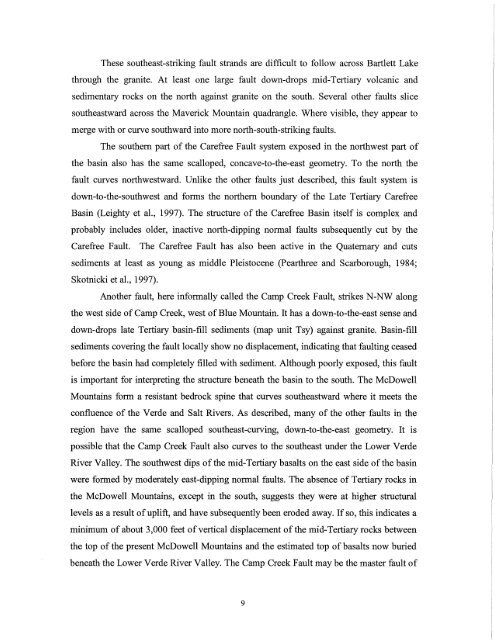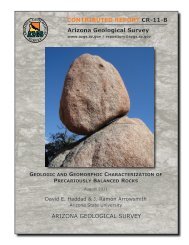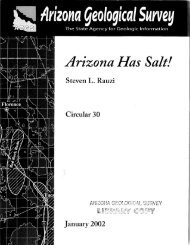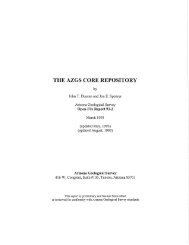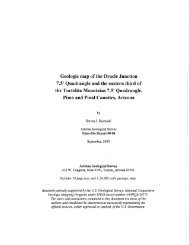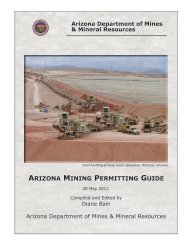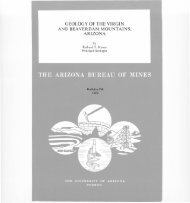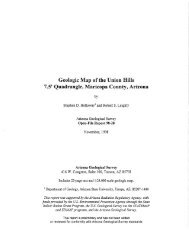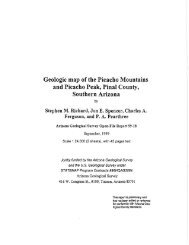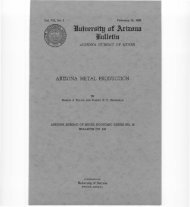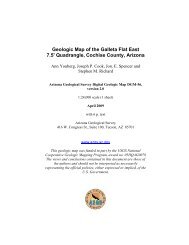Subsurface Geologic Investigation of Fountain Hills - AZGS ...
Subsurface Geologic Investigation of Fountain Hills - AZGS ...
Subsurface Geologic Investigation of Fountain Hills - AZGS ...
You also want an ePaper? Increase the reach of your titles
YUMPU automatically turns print PDFs into web optimized ePapers that Google loves.
These southeast-striking fault strands are difficult to follow across Bartlett Lake<br />
through the granite. At least one large fault down-drops mid-Tertiary volcanic and<br />
sedimentary rocks on the north against granite on the south. Several other faults slice<br />
southeastward across the Maverick Mountain quadrangle. Where visible, they appear to<br />
merge with or curve southward into more north-south-striking faults.<br />
The southern part <strong>of</strong> the Carefree Fault system exposed in the northwest part <strong>of</strong><br />
the basin also has the same scalloped, concave-to-the-east geometry. To the north the<br />
fault curves northwestward. Unlike the other faults just described, this fault system is<br />
down-to-the-southwest and forms the northern boundary <strong>of</strong> the Late Tertiary Carefree<br />
Basin (Leighty et aI., 1997). The structure <strong>of</strong> the Carefree Basin itself is complex and<br />
probably includes older, inactive north-dipping normal faults subsequently cut by the<br />
Carefree Fault. The Carefree Fault has also been active in the Quaternary and cuts<br />
sediments at least as young as middle Pleistocene (Pearthree and Scarborough, 1984;<br />
Skotnicki et aI., 1997).<br />
Another fault, here informally called the Camp Creek Fault, strikes N-NW along<br />
the west side <strong>of</strong> Camp Creek, west <strong>of</strong> Blue Mountain. It has a down-to-the-east sense and<br />
down-drops late Tertiary basin-fill sediments (map unit Tsy) against granite. Basin-fill<br />
sediments covering the fault locally show no displacement, indicating that faulting ceased<br />
before the basin had completely filled with sediment. Although poorly exposed, this fault<br />
is important for interpreting the structure beneath the basin to the south. The McDowell<br />
Mountains form a resistant bedrock spine that curves southeastward where it meets the<br />
confluence <strong>of</strong> the Verde and Salt Rivers. As described, many <strong>of</strong> the other faults in the<br />
region have the same scalloped southeast-curving, down-to-the-east geometry. It is<br />
possible that the Camp Creek Fault also curves to the southeast under the Lower Verde<br />
River Valley. The southwest dips <strong>of</strong> the mid-Tertiary basalts on the east side <strong>of</strong> the basin<br />
were formed by moderately east-dipping normal faults. The absence <strong>of</strong> Tertiary rocks in<br />
the McDowell Mountains, except in the south, suggests they were at higher structural<br />
levels as a result <strong>of</strong> uplift, and have subsequently been eroded away. If so, this indicates a<br />
minimum <strong>of</strong> about 3,000 feet <strong>of</strong> vertical displacement <strong>of</strong> the mid-Tertiary rocks between<br />
the top <strong>of</strong> the present McDowell Mountains and the estimated top <strong>of</strong> basalts now buried<br />
beneath the Lower Verde River Valley. The Camp Creek Fault may be the master fault <strong>of</strong><br />
9


